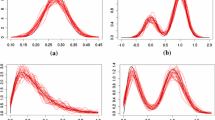Abstract
We develop here a three-stage nonparametric method to estimate the common, group and individual effects in a longitudinal data setting. Our three-stage additive model assumes that the dependence between performance in an audiologic test and time is a sum of three components. One of them is the same for all individuals, the second one corresponds to the group effect and the last one to the individual effects. We estimate these functional components by nonparametric kernel smoothing techniques. We give theoretical results concerning rates of convergence of our estimates. This method is then applied to the data set that motivated the methods proposed here, the speech recognition data from the Iowa Cochlear Implant Project.
Similar content being viewed by others
References
Boularan, J., L. Ferré and P. Vicu (1994). Growth curves: a two-stage nonparametric approach.Journal of Statistical Planning and Inference,38, 327–350.
Boularan, J., L. Ferré and P. Vieu (1995). A nonparametric model for unbalanced longitudinal data with application to geophysical data.Computational Statistics,10, 285–298.
Caussinus, H. and L. Ferré (1992). Comparing the parameters of a model for several units by mean of principal component analysis.Computational Statistics and Data Analysis,13, 269–280.
Doukhan, P. (1994).Mixing: Properties and Examples. Lecture Notes in Statistics, vol 85. Springer-Verlag, New York.
Diggle, P.J. (1988). An approach to the analysis of repeated measurements.Biometrics,44, 959–971.
Diggle, P.J., K.Y. Liang and S.L. Zeger (1994).Analysis of Longitudinal Data. Oxford University Press, Oxford.
Ferreira, E., V. Núñez-Antón and J. Rodríguez-Póo (1997). Kernel regression estimates of growth curves using nonstationary correlated errors.Statistics & Probability Letters,34, 413–423.
Fraiman, R. and J. Meloche (1994). Smoothing dependent observations.Statistics & Probability Letters,21, 203–214.
Gantz, B.J., R.S. Tyler, J.F. Knutson, G.G. Woodworth, P. Abbas, B.F. McCabe, J. Hinrichs, N. Tye-Murray, C. Lansing, F. Kuk and C. Brown (1988). Evaluation of five different cochlear implant designs: audiologic assessment and predictors of performance.Laryngoscope,98, 1100–1106.
Gasser, T., H.G. Müller, W. Kölher, L. Molinari and A. Prader (1984). Nonparametric regression analysis of growth curves.Annals of Statistics,12, 1210–219.
Grizzle, J.E. and D.M. Allen (1969). Analysis of growth and dose response curves.Biometrics,25, 357–381.
Györfi, L., W. Härdle, P. Sardá and P. Vieu (1989).Nonparametric Curve Estimation from Time Series. Lectures Notes in Statistics, vol 70. Springer Verlag, New York.
Härdle, W. (1990).Applied Nonparametric Regression. Cambridge University Press, Cambridge.
Hart, J.D. and T.E. Wehrly (1986). Kernel regression estimation using repeated measurements data.Journal of the American Statistical Association,81, 1080–1088.
Hart, J.D. and T.E. Wehrly (1993). Consistency of cross-validation when the data are curves.Stochastic Processes and Their Applications,45, 351–361.
Houllier, F. (1987). Comparaison de courbes et de modéles de croissance: choix d'une distance entre individus.Statistique et Analyse des Donées,12, 17–36.
Jones, R.H. (1990). Serial correlation or random subject effects?Communications in Statistics B-Simulation and Computation,19, 1105–1190.
Laird, N.M. and J.H. Ware (1982). Random effects models for longitudinal data.Biometrics,38, 963–974.
Lindstrom, M.J. and D.M. Bates (1990). Nonlinear mixed effects models for repeated measures data.Biometrics,46, 673–687.
Longford, N.T. (1993).Random Coefficient Models. Oxford University Press, Oxford.
Muñoz, A., V. Carcy, J.P. Schouten, M. Segal and B. Rosner (1992). A parametric family of correlation structures for the analysis of longitudinal data.Biometrics,48, 733–742.
Núñez-Antón, V. (1993). Analysis of longitudinal data with unequally spaced observations and time dependent correlated errors. Unpublished Ph.D. Dissertation. The University of Iowa, Department of Statistics and Actuarial Science.
Núñcz-Antón, V. and G.G. Woodworth (1994). Analysis of longitudinal data with unequally spaced observations and time-dependent correlated errors.Biometrics,50, 445–456.
Parzen, E. (1962). On estimation of a probability density and mode.Annals of Mathematical Statistics,35, 1065–1076.
Potthoff, R.R. and S.N. Roy (1964). A generalized multiple analysis of variance model useful especially for growth curve problems.Biometrika,51, 313–326.
Rao, C.R. (1965). The theory of least squares when the parameters are stochastic and its application to the analysis of growth curves.Biometrika,52, 447–458.
Rao, C.R. (1967). Least squares theory using an estimated dispersion matrix and its application to measurement of signals.Proceedings of the 5th Berkeley Symposium of the Mathematical Statistical Society,1, 355–372.
Rosenblatt, M. (1956). Remarks on some nonparametric estimates of a density.Annals of Mathematical Statistics,27, 642–669.
Wehrly, T.E. and J.D. Hart (1988). Bandwidth selection for kernel estimators of growth curves with correlated errors (abstract).Institute of Mathematical Statistics Bulletin,17, 236.
Zimmerman, D.L., V. Núñcz-Antón and H. El Barmi (1998). Computational aspects of likelihood-based estimation of first-order antedependence models.Journal of Statistical Computation and Simulation,60, 67–84.
Author information
Authors and Affiliations
Corresponding author
Additional information
This work was supported by DGES, Ministerio Español de Educación y Cultura, and Universidad del País Vasco (UPV/EHU) under research grants PB95-0346 and UPV 038.321-HC236/97.
Rights and permissions
About this article
Cite this article
Núñez-Antón, V., Rodríguez-Póo, J.M. & Vieu, P. Longitudinal data with nonstationary errors: a nonparametric three-stage approach. Test 8, 201–231 (1999). https://doi.org/10.1007/BF02595870
Received:
Accepted:
Issue Date:
DOI: https://doi.org/10.1007/BF02595870




